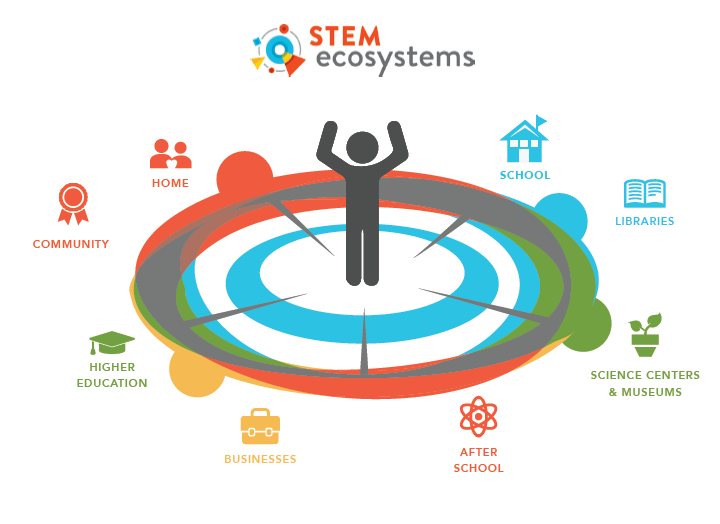National Experts: Forming STEM Ecosystems is "Top Priority"

From the National STEM Ecosystem site:
5-Year Strategic Plan Announced by White House National Science & Technology Council
(WASHINGTON, D.C.) On December 4th, 2018, acting on recommendations of top national education experts, the federal government issued the “Charting A Course for Success: America’s Strategy for STEM Education,” listing participation of all Americans in STEM ecosystems as a top priority.
The plan, announced at the White House, says STEM ecosystems are pathways for improving STEM literacy, ensuring a strong workforce and global competitiveness for all, and an important means to support diversity, equity, and inclusion in a thriving STEM workforce.
STEM ecosystems unite stakeholders from a variety of community-based organizations — including formal and after-school education, higher education, business, government, philanthropy, and the non-profit sector — to cultivate, innovate and work for common goals and actions surrounding world-class STEM opportunities for all learners.
The STEM five-year strategic plan, under development for more than a year, is based on input from numerous stakeholders, including educators, business and community leaders, and representatives from all 50 states who attended a June federal STEM Summit hosted by Office of Science Technology and Policy (OSTP) at the White House.
The plan identifies three discrete goals: 1) Building strong foundations for STEM Literacy; 2) Increasing diversity, equity, and inclusion in STEM and 3) Preparing the STEM Workforce for the Future. The plan identifies methods for achieving the goals with the formation of STEM ecosystems as the leading strategy.
“This pathway focuses on strengthening existing relationships and developing new connections between educational institutions, employers, and their communities. That means bringing together schools, colleges and universities, libraries, museums, and other community resources to build STEM ecosystems that broaden and enrich each learner’s educational and career journey,” the report says.
Speaking at the announcement, Gabriela Gonzalez, deputy director of Intel Corporation, said it will take an ecosystem effort to get this right.
This plan follows a decade of work documenting how STEM is best learned in communities where cross-sector partners are collaborating, learning, and educating together with a national community of practice to facilitate learning, information sharing, and problem solving.
Jan Morrison, founder and president of TIES – Teaching Institute for Excellence in STEM, which designed and continues to lead the STEM Learning Ecosystems Community of Practice and who participated in the OSTP Summit, said, “We celebrate the fifty states’ vision and brilliance in focusing this report on the great value of bringing the work of STEM to all through STEM Learning Ecosystems.”
“The design of our communities as STEM Ecosystems ensures that STEM is central to children’s education both in- and out-of-school and that it is inextricably linked to workforce and a lifetime of solving our world’s grandest of challenges.”
Gerald Solomon, executive director of the Samueli Foundation, and Ron Ottinger, executive director of STEM Next Opportunity Fund, are co-founders of the STEM Learning Ecosystem Initiative, now comprised of 65 communities across the nation.
“STEM Next Opportunity Fund, which has served as one of the lead funders of this initiative, is pleased to see that the new Federal STEM Strategic Plan recognizes the importance of afterschool and the full ecosystem of organizations that must engage and inspire students towards STEM excellence and success,” Ottinger said.
“In the modern world, our children need an all-hands-on deck approach and everyone needs to help — from schools, to higher ed, to industry, to after-school, to parents, to the Federal agencies that drive so much research and innovation. We look forward to working with the Administration and the new Congress to ensure that STEM is equitably funded and serving the needs of all students.”
The Samueli Foundation has been providing financial support since the inception of the STEM Learning Ecosystem Community of Practice. Solomon said, “The Samueli Foundation is proud of its investment in this effort, which began in our backyard in Orange County, California and welcomes the nation to follow the fine work that has been pioneered and developed by the current global communities.”
The STEM Learning Ecosystem Community of Practice, now in its fourth year, was patterned after the Statewide STEM Network initiative developed at the Bill and Melinda Gates Foundation under the leadership of Steve Seleznow, who has since left Gates to lead the Arizona Community Foundation.
About STEM Learning Ecosystems
STEM Learning Ecosystems build strong collaborations in schools and beyond the classroom—in afterschool and summer programs, at home, with local business and industry partners, and in science centers, libraries and other places both virtual and physical. Ecosystems strive to enable students to connect what they learn at home, in school and out-of-school with real-world opportunities.
About TIES Teaching Institute for Excellence in STEM
TIES is dedicated to making STEM accessible to everyone, especially underserved and underrepresented learners. We do this by connecting stakeholders — educators, funders, community organizations, businesses and government agencies — who, through collaborative partnerships, create meaningful and gainful STEM learning experiences. Our team of consultants provides strategic planning support and guides design, training and implementation across all of our services.